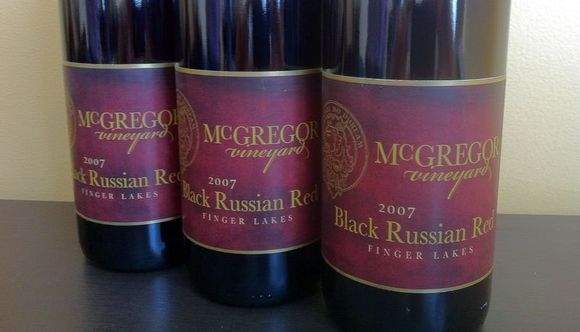By Evan Dawson, Managing Editor
The wine that is quite possibly the single most interesting wine in the Finger Lakes is turning 20, sort of, in 2011, and the McGregor family is throwing a party. (This is a family that really knows how to throw a bash.) Details on the event to follow, but first, let's lift the veil on a little history.
The McGregor Black Russian Red is, technically, older than 20 years. Bob McGregor spent the 1980s searching for the right blends and combination to unlock the potential in these unusual grapes — Saperavi and Sereksiya Charni. Today, you can still find an occasional bottle of 1991 Black Russian hanging around. It was the first recognized vintage of this blend, and if you're fortunate enough to find one, don't be surprised if it's still pretty darn good.
It's a story of innovation and determination, led by Bob McGregor and carried on by his son, John, and family. It is not a stretch to say that Bob was a trailblazer, because McGregor was one of the first to recognize what some Finger Lakes winemakers are only now recognizing: In an unpredictable cool climate region, sometimes you have to open your mind to find what truly works.
Bob McGregor had struggled with Bordeaux varieties. His early pinots made him happy, and earned the praise of a few writers, but Bob wanted that big, robust red to round out his portfolio. That was the goal. Cabernet was dying on the vine, literally, in the 1970s and 1980s. Bob McGregor's background pushed him to search for something different.
He had come from the business of photo chemistry. McGregor worked for Kodak, but it's probably more accurate to say he was a physicist whose brilliant work extended far beyond the walls in Rochester. McGregor had done some work on national security projects. If he could handle that kind of work, what was grape growing, anyway?
Not so simple, it turned out. And Bob wasn't surprised about that. Like Steve Sasson, the Kodak researcher who eventually invented the digital camera, Bob McGregor realized that great success is preceded by many failures.
So when he chatted with Dr. John McGrew of the USDA in 1979, Bob listened. Thirty years later, Bob and I laughed about how the names of these eastern European grapes sounded more like hockey names. Saperavi, Sereksiya, Mtzvani, Rkatsitelli. But was he going to turn down a chance to try them out?
The charm of the McGregor story is that for a decade, these varieties caused him more headaches. "Mtzvani was more of a weed than anything," Bob recently told me. But he didn't give up on the big, dark Saperavi and Black Sereksiya. First he tried them on their own — "They made wine that reminded me of some of the hybrid wines," Bob said — then he blended them. The blend seemed to hold promise, but he was convinced the French oak was holding it back.
By 1991 it was natural for Bob to think he was cursed, doomed with these varieties, and yet he persisted still. That's the year that his move to American oak seemed to change everything. He loved the smokey, bacony character that complemented the wine while allowing its fascinating nuance to show.
Consider that: It had been more than a decade of experimenting with grape varieties that had very little track record anywhere in the world. It's hard to imagine anyone else not giving up, but McGregor plugged on.
Today, John McGregor continues that tradition by conducting experiments of his own. To wit, McGregor Vineyard is preparing to release the 2007 Black Russian Red 30 Month Barrel Reserve. Can the wine stand up to that much time in wood? John McGregor gives an emphatic yes.
"I have no problem stating that this sets the standard in how far Finger Lakes red wines have come — it

